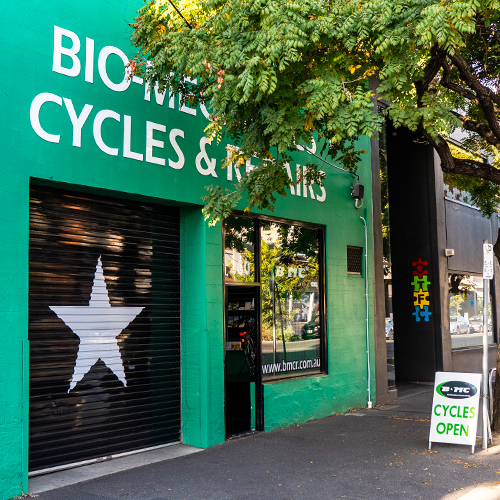Bikepacking in Adelaide & South Australia

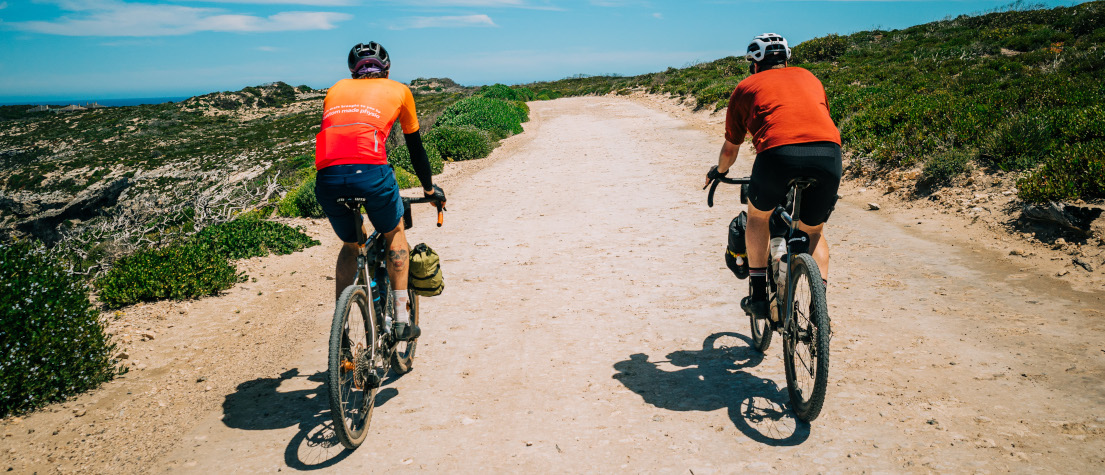
How to make your gravel experience in S.A. a great one, even if you've never done it before
Bikepacking is an awesome way to explore the world. If you don’t know where to begin, however, it can be a bit intimidating. So why not start somewhere local?
In South Australia, we’re spoilt for choice when it comes to backpacking: we’ve got forests, bushland, incredible scenery and views for miles… and you don’t have to travel for hours to get there, either.
In this post, we’re covering the essentials for bikepacking in Adelaide and South Australia, even if you’re a complete novice. We’ll be looking at what to take, how much to take, what to wear, and how to get a good night’s sleep. We’ll also give you some field-tested tips -- including what not to do -- plus links to local suppliers. Special thanks also to our friends (and extensively experienced bikepackers) James and Shane for their input on this one.
Are you ready to ride, camp and ride a bit more? OK! Let’s make sure you have an amazing time, rather than a freezing, regrettable experience.
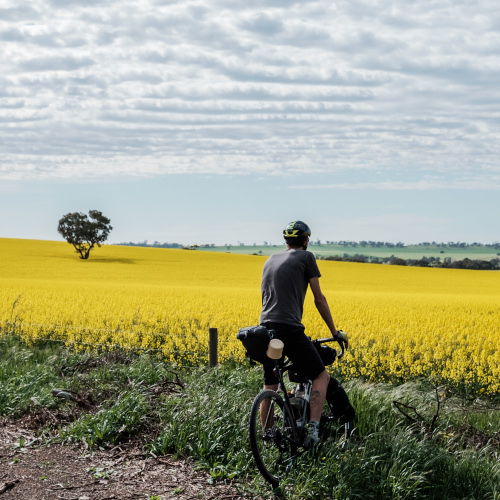
What is bikepacking? A potentially controversial view.
Bikepacking and gravel riding are relatively new disciplines in the cycling world, but have taken off with staggering speed. With this popularity comes debate on what makes or doesn’t make a particular sport. We’ve read multiple blog posts which argue that you have to have a certain type of bike to go bikepacking, or your trip must be a certain distance or number of days, even down to the style of bag you put your snacks in.
Forget all that.
Bikepacking is what you make it. Don’t have a drop-bar bike? No problem. Want to use a backpack instead of panniers? Sure thing. Can’t deal with the idea of sleeping on the ground? Who cares!
If you’re riding somewhere and taking a change of clothes with you, as far as we’re concerned, you’re bikepacking.
With that elimination of snobbery done, let’s get on with it.
So you’ve got a bike. You’ve got some panniers, frame bags or a backpack. Before you stuff them full of muesli bars and frog cakes, let’s break down what you’re actually going to need on your South Australian journey.

What clothes do I need for bikepacking?
Regardless of the distance you’re riding, a good set of knicks/padded shorts is a must.
Well-designed padding will not only keep you comfy but will also help avoid saddle sores, something that’s particularly important on multi-day trips.
In our experience, bib knicks tend to be more comfy than bike shorts as there’s no restrictive waist band. The trade-off is in how much finangling you’ll need to do when nature calls, so to speak, but it’s worth it. Disrobe and be free! The koalas don’t care about seeing your butt. (Just watch out for nettles.)
OK, THEN - WHAT DO I PUT ON MY FEET?
We know that a stiff sole is vital for pedalling efficiency, so if you’re using cleats, a shoe that doubles as a riding and walking shoe will save you weight and storage space.
That being said, you can ride in a pair of sneakers and flat pedals if you want – hell, ride in ballet flats, we don’t care – but for longer trips, it’s definitely worth looking into a clipless setup.
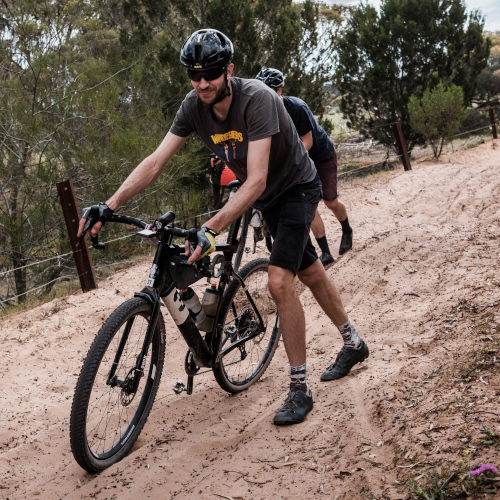
WHAT ABOUT THE REST OF MY BODY?
One word: merino.
Despite being the driest state in Australia, South Australia can get incredibly cold in the winter, not to mention scorching in summer, so a material that works for both environments is a boon. Merino wool fits the bill perfectly. In sweaty conditions, it pulls moisture away from your skin to keep you cool and dry – unlike fabrics like cotton, which stick to you when wet.
Merino wool is also breathable, lightweight and odour-resistant – something that you (and anyone you’re travelling with) will certainly appreciate after a hard day’s riding.
If merino isn't an option, you can go bikepacking in a regular t-shirt, but make sure to check the density first. Hold it up to the light—can you see through it? If so, pick something else or you’ll end up like Lia, who got scorched through a thin top on the Mawson trail, resulting in several sleepless, blistery nights that she’d rather forget. The South Australian sun takes no prisoners.
Bonus tip: if you're bikepacking in winter, pack a sleep beanie and thank us later.
Handy local resources:
- Cycle Closet for knicks, shorts and jerseys
- ioMerino for all things merino
- BMCR for Northwave cycling shoes
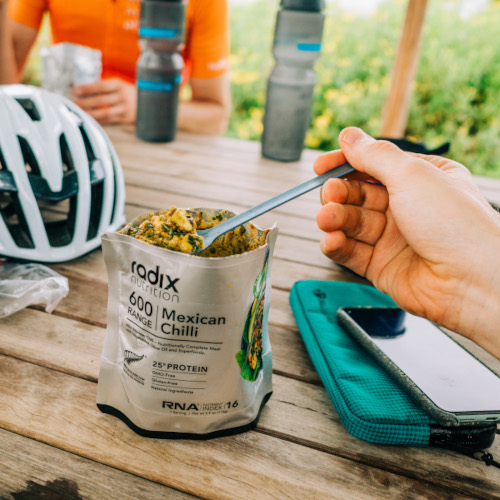
What food will I need on my bikepacking trip?
When you’re first dipping your toes into bikepacking, plan your route around small towns where you’ll be able to refuel. A country bakery is a bike rider’s best friend.
However, there are two things to be mindful of:
- Be aware of the distance. Your camp may only be 10kms away from the nearest local supermarket, but after a long day on the bike, 10km can feel like 100km.
- Make sure to check their opening hours in advance. There’s nothing worse than spending hours dreaming of a pastie with sauce, then rocking up, tired and hungry, only to find a ‘closed’ sign.
An easy main meal solution is to pack ready-made food that doesn’t require any prep or heating. Wraps are great – when is a burrito not a welcome sight? Dried fruit, nuts, peanut butter, and non-melty sweets also travel well. Peaches, on the other hand, do not. (Ask Pete how he knows.)

You’ll naturally also want to consider the weather when packing snacks and/or dinner. If it’s cool, you can add chocolate, cheese and cured meats/vegan jerky to your repertoire. In summer, however, they’re not a great idea unless you’re deliberately trying to contract salmonella, in which case pack all the salami you want.
If you’re feeling a bit more adventurous, take a camping stove and fuel with you. That way you can hunker down with a hot meal or coffee, always a highlight on a chilly day.
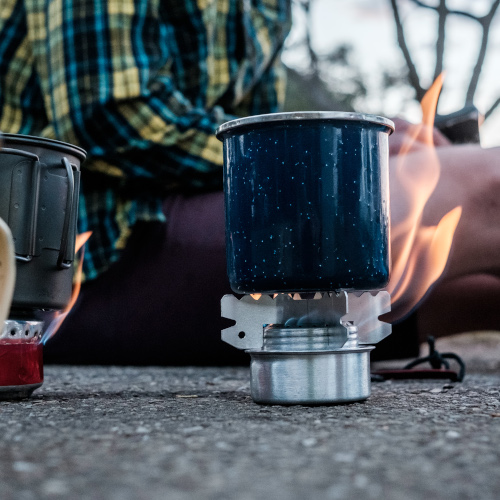
Regardless of what you’re taking, food is one area that you can afford to over-pack. Besides, if you do pack too much, you can just eat the excess and voila! It’s gone. Try doing that with a tent.
Handy local resources:
- BMCR customer favourites include: Clarendon Bakery, Lobethal Bakery, Cudlee Creek Cafe, Port Elliot Bakery, Rise Artisan Bakery, Beck's Bakery Port Noarlunga, and Uraidla Brewery and Bakery. See the full list of recommendations from hungry cyclists here.
- Broadsheet wants you to try 7 regional South Aussie bakeries.
- Google: food near me.
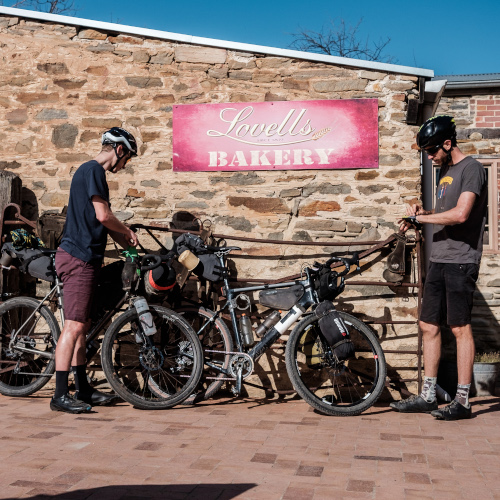
How much water do I need to drink when bikepacking in South Australia?
Dehydration can be a real and serious problem for bikepackers. As a general rule of thumb, you should be aiming to drink around 750ml—which amounts to about one full water bottle—every couple of hours. On a hot day, you’ll need to drink more.
The problem is that water can be hard to get hold of. Many people assume that you can find water sources in forestry areas.
Wrong.
As per the Forestry SA website:
...our campgrounds and accommodation facilities are not connected to mains water. Rainwater tanks in our campgrounds are to service our toilets or for firefighting purposes. Rainwater tank water is not suitable for drinking. Please bring water with you when you visit.
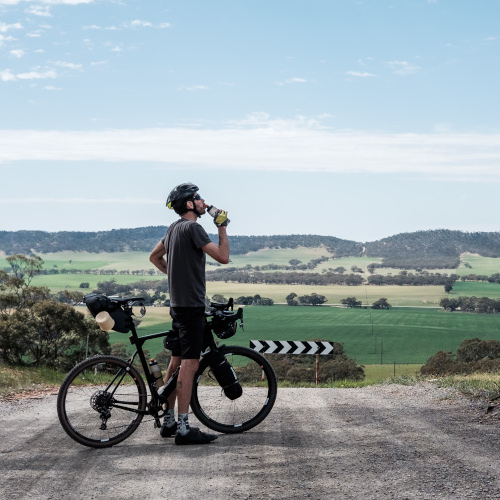
SO HOW DO YOU GET WATER WHEN BIKEPACKING IN SA?
Again, this is where planning your route around small towns can be very important. Look for grocery stores, supermarkets and service stations where you can refill.
You’ll also want to carry several water bottles. If your bike has multiple mounting points, including on the fork legs, this is a huge bonus.
You can carry a water bladder in a pannier or frame bag too, but remember that water is heavy, so keep this in mind if you’re wanting to keep things as light as possible.
Handy local resources:
- SAWater's BYOB - Bring Your Own Bottle app lists local drinking fountains and places where you can refill your bottles.
- You’ll also want to read our easy guide on spotting heatstroke and how to prevent it.
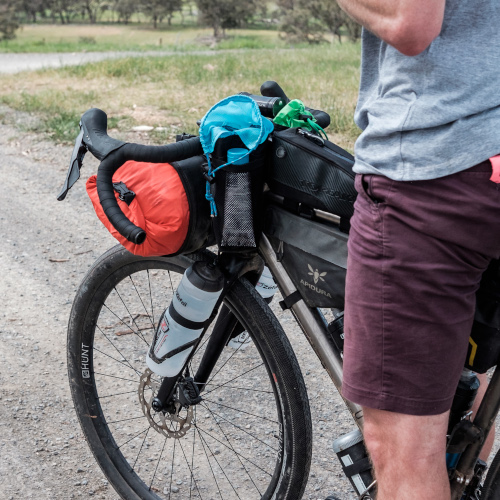
How to get a good sleep on a bikepacking trip
Your sleeping setup is key to a great experience. A decent sleep will mean you’re refreshed for the next leg of your trip. If you spend the whole night shivering or soggy, the following day is probably going to suck.
First up: invest in a good-quality sleeping bag, as it will pay for itself over and over again. There are some bikepacking items you can potentially skimp on (do you really need artisanal oat cakes? No, you don’t) but this isn’t one of them. As Shane says, “If you’re having a bad night, by 2am you’d pay any price to be comfortable.”
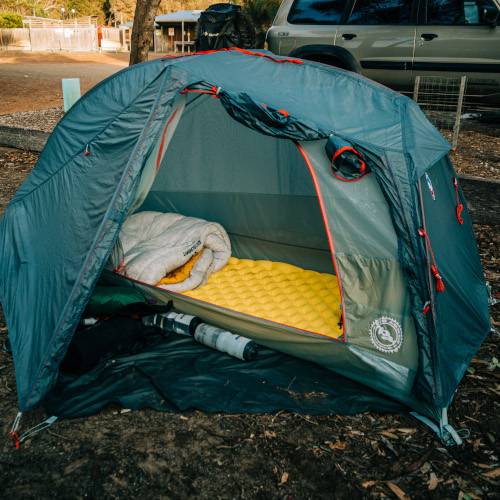
WHAT KIND OF SLEEPING BAG DO YOU NEED FOR BIKEPACKING?
First and foremost, something lightweight, as you’re going to be lugging that sucker around. Bonus points if it packs down small, especially if it can fit in a cargo cage.
Secondly, check the temperature rating. Make sure it will be correct for the conditions you're going to encounter. A bag might be fine for an autumn trip in the Adelaide hills, where the overnight temps could in the mid-teens, but that same bag in Wilpena Pound will leave you freezing.
Optional but beneficial extras:
- A hood, for added protection against the elements
- A full-length zipper; the relief of being able to throw a sweaty leg out of your bag in warmer weather is unparalleled.
- If you’ve got room, an insulated sleeping pad to help keep you warm on chilly ground. Some sleeping bags even have a designated sleeve inside the base to stop the pad moving around.

DO YOU NEED A TENT FOR BIKEPACKING?
This depends on how long your trip is, and how lightweight you’re wanting to go. For mosquito-prone areas, we’d highly recommend it – an insect-free retreat you can sit in is a godsend, especially when you’re eating, so the flies don't drive you bonkers.
If you’re going minimal, opt for a bivouac sac/bivy, which is a waterproof cover for your sleeping bag. Try to find one with a built-in shelter to help keep flying pests out.
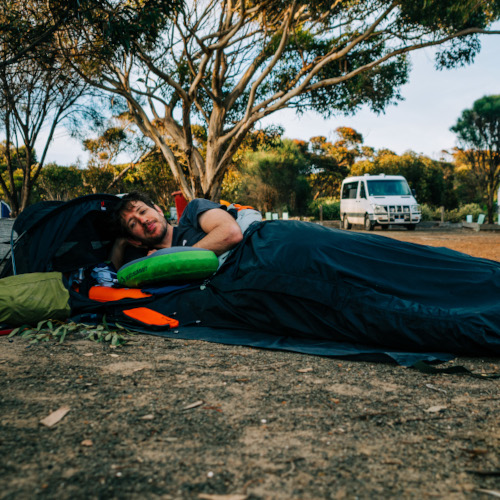
Some forestry areas have huts, and some huts even have beds and fireplaces, which are a luxury when you’re cold and tired. (Note: you will need to book. Links are below.)
No hut? No problem. All you need is a nice flat spot to set up camp. Don’t, however, set up under a tree. As cosy as it may seem, there’s the very real danger of getting hurt by a falling branch, so steer clear. (And, really, is 'crushed by timber' the way you want to die?)
Handy local resources:
- Forestry SA accommodation and camping.
- Exurbia (previously known as the Scout Outdoor Centre) for clothes and accessories. The staff are experienced and really know their stuff.
- Snowy's Outdoors, for tents, sleeping bags, stoves and pretty much anything else. The in-store range is extensive; their Keswick store is huge!

What other bikepacking accessories do I need?
We’ve covered clothing, food, water and sleeping arrangements, so let’s check out some excellent additions to your kit which won’t take up too much space.
SUNSCREEN
This one is a biggie for warm weather, but it’s advisable all year round in South Australia. Yes, if it’s bucketing down, you probably aren’t going to get burnt, but even on cloudy days, your skin is still absorbing UVA rays. So lotion up and keep your cheeks peachy.
LIP BALM
Heed the words of Jeremiah Bishop, the founder of Alpine Loop Gran Fondo, when asked about his bikepacking essentials:
"Lip balm. I would have given a hundred bucks for a stick of lip balm in Death Valley. I am not kidding. Lip balm is permanently on my bikepacking list now.” *
Your lips can crack only a couple of days into a ride, so this stuff will save you from a lot of pain. Make sure to find one with a built-in SPF. (Yes, your lips can get sunburnt, too, and it’s horrible, so avoid it.)
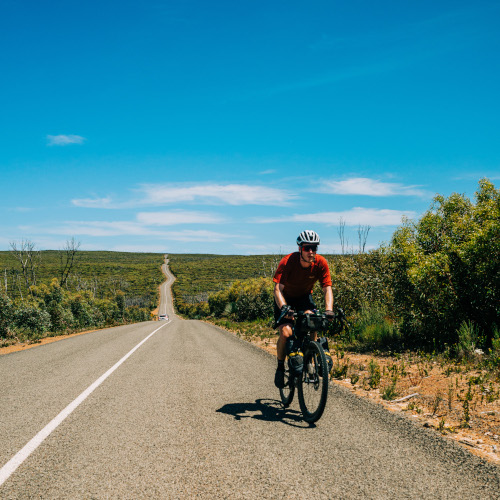
EMERGENCY SPARES
This includes a tube, plugs (if you’re running tubeless), toilet paper and a quick link for your chain.
If your bike runs a detachable derailleur hanger, bringing a spare one is also a great idea, because if you break your current hanger and don’t have another, that’s the end of your trip.
On the more obscure end, a seat post clamp bolt takes up virtually no room but is very handy to have, just in case.
If your bike is set up tubeless and you're riding with friends, it can also be useful if you're all using the same sealant. Many sealants aren't cross-compatible, so having the same brand will make packing and repairs much easier. (The same goes for quick links and chain lube, should your trip be long enough or in weather conditions to warrant the latter.)

Where to go backpacking in South Australia
OK, you're ready to roll... but where do you go?
To make it easy to start with, here are some of our favourites:
- The Lavender Cycling Trail is great for beginners as well as more experienced riders. It covers Murray Bridge to Clare (M2C) along dirt roads and tracks. James has done a great write-up for La Velocita on this trail, too.
- The Mawson Trail. A classic, and can be done in stages, or top to bottom (or bottom to top). Best visited in Spring when everything's green and blooming. If you're going from bottom to top, you'll also really love the roll down the hill into Melrose, which stops at the pub.
- The Kidman Trail, plus check out James's Kidman article with some beautiful pics
- Want some day trip ideas instead? James has got you covered.
If there’s a particular area of South Australia not covered here that you’re keen to explore, pick a patch and then develop a route around the available camping spots and towns.
Designing a good route takes time, however, and sometimes what looks good on screen or paper might not work in real life.
Heed the words of James: “You may look at it, thinking 60km between towns/water stops is fine but smash through your water in 30km.”

Before you go on your bikepacking trip
Yes, you're almost ready to roll, but there are a couple of final notes.
GET YOUR BIKE SERVICED
There’s no point doing all your ride preparation and planning only to discover on the day that your gears don’t work or your brakes are dragging.
A pre-bikepacking service will not only make sure that your bike is performing properly but also find any potential issues that could be catastrophic out in the field (e.g. derailleur going into the spokes, fork steerer snapping, cracked rim giving way).
Schedule the service to take place at least a week ahead of the ride so you can test it out before you go.
Remember: good workshops are usually busy, so book as early as possible. Don’t be the person who leaves it to the day before they’re riding to Clare, and is then surprised that there’s no mechanic available.
TEST OUT YOUR GEAR FIRST
This is crucial, especially if you’re planning a multi-day trip. Saddle sores and uncomfortable shoes can ruin a nice ride, and what works in your living room may not work out in the middle of a forest.
On this topic, when you’re shopping for bikepacking gear, don’t assume everything fits. There’s no point buying a rack if your frame has no mounting points, or a handlebar roll bag if you can't squeeze it in between the drops on your handlebars. Take your bike with you to the shop to ensure that you’re picking up the right stuff. (Another excellent reason to #buylocal.)
Once you’ve set up your bike with all your gear, try to do a loaded test-run. This is how you can discover potential problems in advance – e.g. a loaded handlebar bag crushes a crucial cable, you’re suffering heel strike with your panniers – and fix the issues before you head out into the wilderness (or, worse, end up suffering a bag/bike failure in a remote area).
“I have done a few one-night trips just to check how the gear fits on the bike and how it works in nature.” - Shane
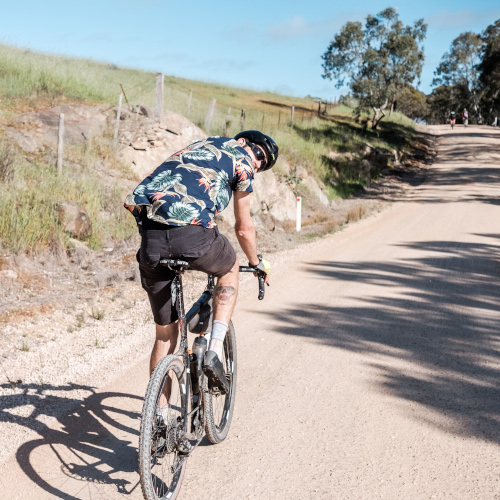
DON'T RELY ON MOBILE COVERAGE
Speaking of remote areas, don’t rely on your phone as your only source of navigation. Mobile phone access can be patchy across South Australia once you’re out of densely populated areas.
Download any relevant maps in advance so you won’t be caught out if there’s no network access.
If you're using the BYOB water app we mentioned earlier, don't forget to mark any water refilling spots on your maps, too.
Print out any information you'll need on the trip, and keep it in a waterproof pocket.
CHECK FOR FIRE BANS
Forestry SA areas are a no-go zone on total fire ban days. That's right - no riding, no walking, nothing.
In the warmer months, make sure to check the CFS website and Facebook page before you head off. If it's a total fire ban day, stay out of those areas and plan your trip for another day, or head out to a different area.
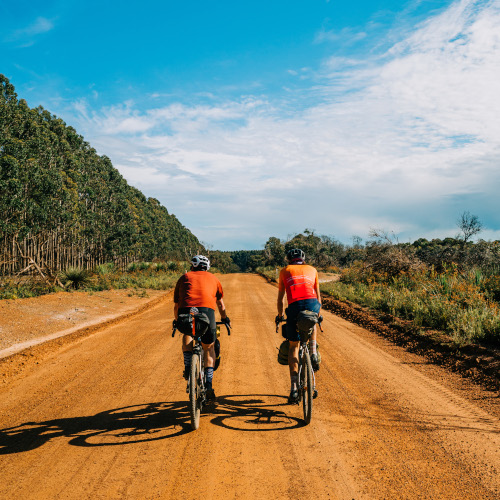
FINALLY: BEWARE OF RED CLAY
One of the things that makes bikepacking in South Australia so amazing is the famous red dirt. This soil is mostly found from Clare northwards, and is a beautiful landscape feature.
However.
(You knew there was a 'however' coming, didn't you.)
Once you add water, this gorgeous red dirt becomes a bike-clogging, momentum-stopping mud machine. It can be so bad that people have admitted defeat and loaded their bike onto the nearest bus to go home.
So if you’re heading into this area, check the forecast and hope for clear skies.
Oh, and white clay is a pain in the butt as well. Let's just say, clay sucks overall.

So there’s your guide to South Australian bikepacking!
Get some well-designed kit, make friends with wraps, and invest in a good sleeping bag.
No matter what any blog post says, you can do any kind of riding on any kind of bike. Some bikes will make it easier than others, but at the end of the day, the important thing is that you’re doing it.
Once you’ve done a bit of homework on your routes and know where you can get water, all you need to do is check BOM, grab your sunscreen and get rolling.
As James says, if you can’t be bothered with camping or food preparation, just get some friends, get your bikes, grab a change of clothes and stay in a pub/AirBnB on the night.
It’s still bikepacking.
It’s all good.
Thanks again to James and Shane for the input, and also to James for the photos used throughout this post. ♥
* Jeremiah Bishop quote via the NBDA's Bicycle Retail Radio, November 2021.


